| |
Ragi / Finger millet (Eleusine coracana) |

Ragi Information System
|
Irrigated
- Marghazipattam (Dec - Jan)
All districts except Kanyakumari & Nilgiris |
CO 9, CO 13, CO (Ra) 14 , TRY 1 |
- Chithiraipattam (April - May)
All districts except Kanyakumari & Nilgiris |
CO 9, CO 13, CO (Ra) 14 |
Rainfed
All districts except Kanyakumari & Nilgiris |
Paiyur 1, CO 13, CO (Ra) 14, Paiyur 2 |
- Puratasipattam (September - October)
| All districts except Kanyakumari & Nilgiris |
Paiyur 1, CO 13, CO (Ra) 14 |
|
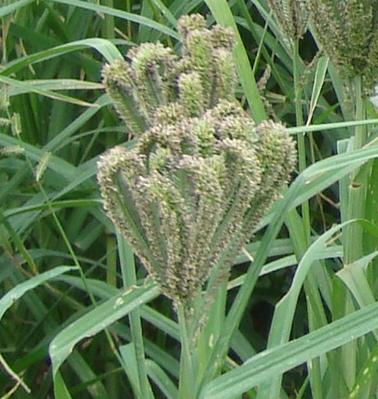 |
|
PARTICULARS OF RAGI STRAINS
PARTICULARS |
CO 9 |
CO 13 |
CO (Ra) 14 |
| Parentage |
EX 4336 x PLR 1 |
CO 7 X TAH 107 |
Malawi 1305 x CO 13 |
| Duration (days) |
100-105 |
95 - 100 |
105-110 |
| Season |
|
|
|
| Rainfed/ Irrigated |
Both |
Both |
Both |
| Grain yield kg/ha |
|
|
|
| Irrigated |
4500 |
3600 |
2892 |
| Rainfed |
3100 |
2300 |
2794 |
| Straw yield kg/ha |
|
|
|
| Irrigated |
8000 |
10000 |
8113 |
| Rainfed |
6500 |
7500 |
8503 |
| Stem |
Erect |
Erect |
Erect |
| Height (cm) |
75-80 |
85 - 90 |
115-120 |
| Tillers |
5-8 |
3 - 5 |
8-9 |
| Days to 50% flowering |
65-70 |
55 - 60 |
72 |
| Ear size and shape |
incurved fingers |
Open |
top curved |
| Fingers |
8-9 |
10 –17 |
9-12 |
| Ear length (cm) |
8 |
8-10 |
10-12 |
| Grain colour |
White |
Light Brown |
Brown |
| 1000 grain wt (g) |
2.7 |
1.7 |
3.1 |
PARTICULARS |
Paiyur 1 |
TRY 1 |
Paiyur 2 |
| Parentage |
Pureline selection from
PR 722 |
Selection from HR 374 |
VL 145 x Selection 10 |
| Duration (days) |
115-120 |
102 |
115 |
| Season |
|
|
|
| Rainfed / Irrigated |
Rainfed |
Kharif irrigated Sodic/ saline soils |
Rainfed |
| Grain yield kg/ha |
|
|
|
| Irrigated |
.. |
4011 |
-- |
| Rainfed |
3125 |
.. |
2527 |
| Straw yield kg/ha |
|
|
|
| Irrigated |
.. |
6800 |
-- |
| Rainfed |
5750 |
.. |
4200 |
| Stem |
Erect |
Erect |
Errect |
| Height (cm) |
110 |
100 |
90 |
| Tillers |
1 - 3 |
5 - 7 |
3-4 |
| Days to 50% flowering |
80 |
78 |
81 |
| Ear size and shape |
Open |
Incurved |
Incurved |
| Fingers |
6 - 8 |
5-8 |
7-8 |
| Ear length (cm) |
8 |
7.6 |
7.0 |
| Grain colour |
Brown |
Brown |
Brown |
| 1000 grain wt (g) |
2.7 |
2.74 |
2.9 |
IRRIGATED
CROP MANAGEMENT
I. PREPARATION OF NURSERY (IRRIGATED TRANSPLANTED CROP)
1. PREPARATION OF LAND
- For raising seedlings to plant one ha of main field, select 12.5 cents (500 m2) of nursery area near a water source, where water does not stagnate.
- Mix 37.5 kg of super phosphate with 500 kg of FYM or compost and spread the mixture evenly on the nursery area.
- Plough two or three times with a mould board plough or five times with a country plough.
2. FORMING RAISED BED
- Mark units of 6 plots each of size 3 m x 1.5 m. Provide 30 cm space between plots for irrigation.
- Excavate the soil from the interspace and all around to a depth of 15 cm to form channels and spread the soil removed from the channels on the bed and level.
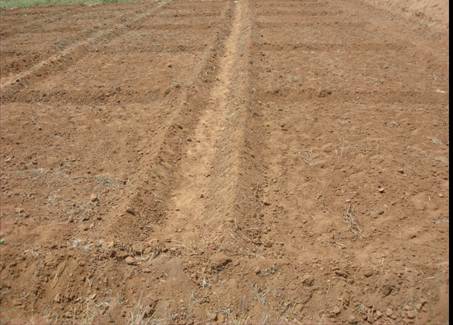
Form Raised Bed of size 3 m x 1.5 m
3. PRE-TREATMENT OF THE SEEDS WITH FUNGICIDES
- Seed treatment with Azospirillum may be done @ 3 packets/ha (600 g/ha) and 3 packets (600 g/ha) of Phosphobacteria or 6 packets of Azophos (1200 g/ha).
- Mix the seeds in a polythene bag to ensure a uniform coating of seeds with Thiram 4 g/ kg or Captan 4 g/kg or Carbendazim 2 g/kg of seeds.
4. SOWING AND COVERING THE SEEDS
- Make shallow rills not deeper than one cm on the beds by passing the fingers vertically over them.
- Broadcast 5 kg of treated seeds evenly on the beds.
- Cover the seeds by levelling out the hand lightly over the soil.
- Sprinkle 500 kg of powdered FYM over the beds evenly to cover the seeds which are exposed and compact the surface lightly.
NOTE: Do not sow the seeds deep as germination will be adversely affected.
5. WATER MANAGEMENT
- Provide one inlet to each nursery unit.
- Allow water to enter through the inlet and cover all the channels around the beds. Allow the water in the channels to raise till the raised beds are wet and then cut off water.
- Adjust the frequency of irrigation according to the soil type.
No. of irrigations |
RED SOILS |
HEAVY SOILS |
1st |
Immediately after sowing |
Immediately after sowing |
2nd |
3rd day after sowing |
4th day after sowing |
3rd |
7th day after sowing |
9th day after sowing |
4th |
12th day after sowing |
16th day after sowing |
5th |
17th day after sowing |
.. |
NOTE:
- One irrigation is given on the 3rd day in the case of red soil to soften the hard crust formed on the soil surface and also to facilitate seedlings to emerge out.
- Do not allow cracks to develop in the nursery bed by properly adjusting the quantity of irrigation water.
6. PULLING OUT THE SEEDLINGS FOR PLANTING
Pull out seedlings on the 17th to 20th day of sowing for planting.
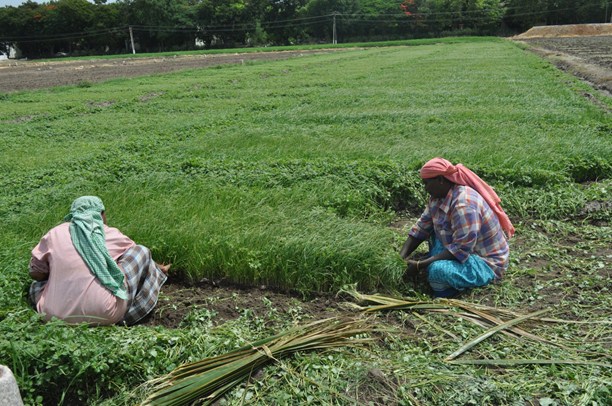
II. PREPARATION OF MAIN FIELD
1. PLOUGHING THE FIELD
Plough twice with mould board plough or thrice with wooden plough till a good tilth is obtained.
2. APPLICATION OF FYM OR COMPOST
Spread 12.5 t/ha of FYM or compost or composted coir pith evenly on the unploughed field and then plough and incorporate in the soil. NOTE: Do not spread and leave the manure uncovered in the field as nutrients will be lost.
3. APPLICATION OF FERTILIZERS
- Soil test based fertilizer recommendations may be adopted in Western and North Western Zones in soils of Vertisols, Alfisols, Inceptisols and Entisols for prescribing the fertilizer doses for specified yield targets. In soils having high intensive cropping system viz., Ragi-Maize-Cowpea, having high soil available K (310 kg/ha) potassium need not be applied. Apply NPK fertilizers as per soil test recommendation as far as possible. If soil test recommendation is not available, adopt a blanket recommendation of 60 kg N, 30 kg PO5 and 30 kg K2O5 per ha.
- Apply half the dose of N and full dose of N and full dose of P2O5 basally before planting.
- Broadcast the fertilizer mixture over the field before the last ploughing and incorporate into the soil by working a country plough.
- Apply 10 packets/ha (2000 g) of azospirillum and 10 packets (2000 g/ha) of Phosphorous solubilizing bacteria or 20 packets of Azophos (4000 g/ha) after mixing with 25 kg of soil and 25 kg FYM before transplanting.
4. FORMING BEDS AND CHANNELS
- Form beds of size 10 m2 to 20 m2 according to topography of the field.
- Provide suitable irrigation channels.
5. APPLICATION OF MICRONUTRIENT MIXTURE
- Mix 12.5 kg of micronutrient mixture formulated by the Department of Agriculture, Tamil Nadu with enough sand to make a total quantity of 50 kg/ha.
- Apply the mixture evenly on the beds.
- Do not incorporate the mixture in the soil.
III. MANAGEMENT OF MAIN FIELD
1. TRANSPLANTING THE SEEDLINGS
- Let water into the bed, level the bed, if it is not levelled.
- Plant 2 seedlings per hill.
- Plant the seedlings at a depth of 3 cm.
- Plant 18 to 20 days old seedlings.
- Adopt a spacing of 30x10 cm for planting.
- Adopt 22.5 x 10 cm spacing for direct sowing.
- Root dipping with Azospirillum prepare slurry with 5 packets (1000 g)/ha of Azospirillum and 5 packets (1000g/ha) of Phosphobacteria or 10 packets of Azophos (2000 g/ha) in 40 litres of water and dip the root portion of the seedlings in the solution for 15-30 minutes and transplant.
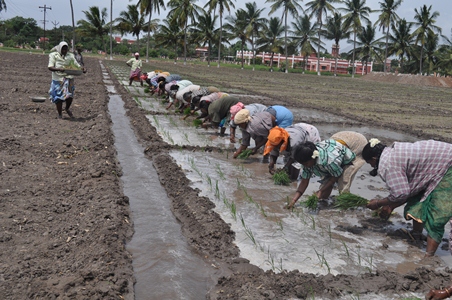 |
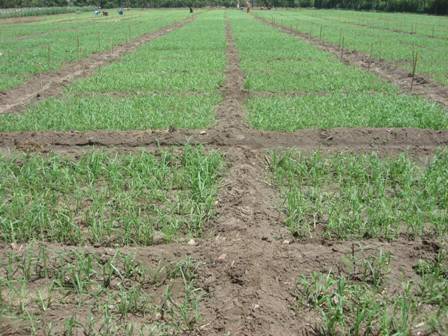 |
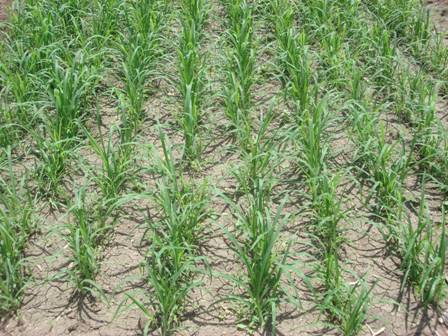 |
| Adopt a spacing of 30x10 cm for planting |
2. WEED MANAGEMENT
- Apply PE Oxyfluorfen @ 0.05 kg a.i/ha on 3 DAS using Backpack Knapsack/Rocker sprayer fitted with flat fan type of nozzle with 500 litre of water/ha followed by one hand weeding on 20 DAS.
- Apply the herbicides when there is sufficient moisture in the soil or irrigate immediately after application of herbicide.
- If pre-emergence herbicide is not applied, hand weed twice on 10th and 20th day after transplanting.
- For rainfed direct seeded crop, apply post emergence herbicide; 2,4-DEE or 2,4-D Na salt at 0.5 kg/ha on 10th day after sowing depending on the moisture availability.
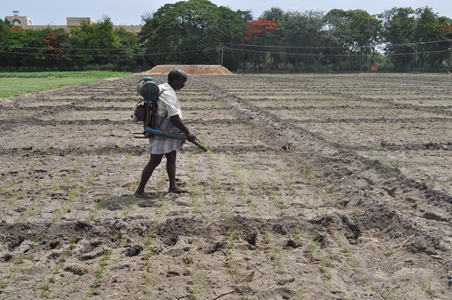
Pre-emergence herbicide |
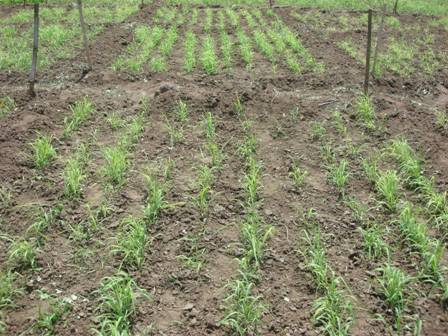
Weed free ragi field |
3. HOEING AND HAND WEEDING
- Hoe and hand weed on the 15th day of planting in light soils and 17th day of planting in heavy soils and subsequently on 30th and 32nd days, respectively.
- Allow the weeds to dry for 2 or 3 days after hand weeding before giving irrigation. NOTE: Do not adopt hoeing and hand weeding if herbicide is applied.
IV. WATER MANAGEMENT
Regulate irrigation according to the following growth phases of the crop
| Stages |
No. of
irrigations |
80 days |
Crop duration
100 days |
120 days |
Vegetative phase(Nursery)
|
|
1 to 16 |
1 to 18 |
1 to 20 |
Vegetative phase
(in main field) |
|
1 to18 |
1 to 20 |
1 to 22 |
| Flowering phase |
|
19 to 40 |
21 to 55 |
23 to 69 |
| Maturity phase |
|
Beyond 40 days |
Beyond 55 days |
Beyond 69 days |
| Heavy soils |
|
|
|
|
| Establishment |
1 |
1st day |
1st day |
1st day |
| (1-7 days) |
2 |
5th day |
5th day |
5th day |
| Vegetative phase |
1 |
18th day |
20th day |
20th day |
| (8-20 days) |
2 |
31st day |
33rd day |
30th day |
| Flowering phase |
1 |
41st day |
42nd day |
37thd ay |
| (21-55 days) |
2 |
51st day |
52nd day |
44th day |
| |
3 |
-- |
-- |
63rd day |
| Maturity phase |
1 |
61st day |
62nd day |
78th day |
| (56-120 days) |
2 |
-- |
-- |
93rd day |
| Stop irrigation thereafter |
|
|
|
|
| Light soils |
|
|
|
|
| Establishment |
1 |
1st day |
1st day |
1st day |
| (1 – 7 days) |
2 |
5th day |
5th day |
5th day |
| Vegetative phase |
1 |
15th day |
16th day |
16th day |
| (8 - 20 days) |
2 |
26th day |
28th day |
28th day |
| Flowering phase |
1 |
36th day |
36th day |
36th day |
| (21 - 55 days) |
2 |
45th day |
45th day |
45th day |
| |
3 |
.. |
54th day |
54th day |
| Maturity phase |
1 |
58th day |
69th day |
78th day |
| (56 - 120 days) |
2 |
70th day |
85th day |
93rd day |
| Stop irrigation thereafter |
|
|
|
|
| |
|
|
|
|
| NOTE: The irrigation schedule is given only as a general guideline. Regulate irrigation depending upon the prevailing weather conditions and receipt of rain. |
V. HARVESTING
1. DECIDE WHEN TO HARVEST
- Ragi crop does not mature uniformly and hence the harvest is to be taken up in two stages.
- When the earhead on the main shoot and 50% of the earheads on the crop turn brown, the crop is ready for the first harvest.
2. HARVEST OF THE CROP
First harvest
- Cut all earheads which have turned brown.
- Dry, thresh and clean the grains by winnowing.
Second Harvest
- Seven days after the first harvest, cut all the earheads including the green ones.
- Cure the grains to obtain maturity by heaping the harvested earheads in shade for one day without drying, so that the humidity and temperature increase and the grains get cured.
- Dry, thresh and clean the grains by winnowing and store the grains in gunnies.
i. Threshing
Green earheads if harvested will contaminate the seeds with immature seeds and interfere cleaning, drying and grading. Dry earheads until seed moisture content is 15% and separate manually by threshing with bamboo stick or machine thresher.
ii. Precleaning and drying
Threshed seeds should be precleaned before sundrying, seeds must be dried to 12% before grading.
Protection from storage pests
- Grain purpose: Dry the seeds adequately to reduce the moisture level to 10%.
- Seed purpose: Admix one kg of Activated kaolin or Malathion 5% D for every 100 kg of seed. Pack in gunny or polythene lined gunny bags for storage.
Special Problems
- Root Aphids: Mix Dimethoate 3 ml in one litre of water and drench the rhizosphere of the infested and surrounding plants with the insecticidal solution.
- Rainfed ragi: Azospirillum mixed with FYM and applied to field saves the cost of nitrogen by 50% with a comparable yield obtained with 40 kg N/ha.
- Management of aged seedlings of ragi under rainfed conditions: When planting ragi seedlings beyond 21 days, increase the number of seedlings to 3/hill and increase N level by 25% to minimise yield loss.
- Apply VAM culture (Glomus fasciculatum) at 100 g/m2 in the nursery and also treat with Azospirillum and Phosphobacterium as seed treatment, seedling dip and field application to reduce the reniform nematode population in ragi.
RAGI : RAINFED
Rainfall
Average and well distributed rainfall of 450-500 mm is optimum for rainfed ragi
Season
Finger millet is grown in different seasons in different parts of the country. As a rainfed crop, it is normally sown in June- July in Tamil Nadu. It also grown in winter season (rabi) by planting in September – October in Tamil Nadu and as a summer irrigated crop by planting January – February.
Tillage
Fallow ploughing is advantageous for moisture conservation. In the month of April or May, one deep ploughing with mould board plough followed by ploughing with wooden plough twice is necessary. Before sowing secondary tillage with cultivator and multiple tooth hoe to prepare smooth seed bed is necessary.
Seed rate and planting
A plant population of 4 – 5 lakhs per ha is optimum for getting higher yields and higher or lower population than the optimum will reduce the yield. Line sowing is ideal and seed drills giving spacing of 22.5 – 30 cm between rows should be used. Finger millet seeds are very small (400 seeds/g) and the recommended seed rate of 15-20 kg per hectare will contain about 4 million seeds. Therefore, even when seed drill is used thinning within the row leaving a spacing of 7.5 – 10 cm between plants, must be followed.
Sowing by seed-cum-fertilizer drill is advantageous for line sowing besides efficient utilization of applied nutrients.
Maintenance of optimum plant population is an important prerequisite for getting higher yield under rainfed conditions. Poor germination, often, is the result of inadequate moisture after sowing in low rainfall areas. Under these conditions, the adoption of a simple technique like seed hardening will not only improve germination and subsequent plant stand but also impart early seedling vigour and tolerance to drought.
The procedure of seed hardening technique is as follows.
- Sole seeds in water for 6 hours. Use one litre water for every kg seed for soaking.
- Drain the water and keep the seeds in wet cloth bag tightly tied for two days.
- At this stage, the seeds will show initial signs of germination.
- Remove seeds from the wet cloth bag and dry them in shade on a dry cloth for 2 days.
- Use the above hardened seeds for sowing.
Manuring and fertilization
Finger millet responds well to fertilizer application especially to N and P. The recommended doses of fertilizers vary from state to state for rainfed crop. Recommended dose of 40:20:20 kg/ha N:P:K was applied. With judicious application of farmyard manure inorganic fertilizer efficiency is enhanced. Entire P2O5 and K2O are to be applied at sowing, whereas nitrogen is to be applied in two or three split doses depending upon moisture availability. In areas of good rainfall and moisture availability, 50% of recommended nitrogen is to be applied at sowing and the remaining 50% in two equal splits at 25-30 and 40-45 days after sowing. In areas of uncertain rainfall, 50% at sowing and the remaining 50% around 35 days after sowing is recommended.
Bio-fertilizers
Treating seeds with Azospirillum brasilense (N fixing bacterium) and Aspergillus awamori (P solubilizing fungs) @ 25 g/kg seed is beneficial. In case seeds are to be treated with seed dressing chemicals, treat the seeds first with seed dressing chemicals and then with bio-fertilizers at the time of sowing.
Procedures for inoculating seeds with biofertilizers
- Bio-fertilizer culture specific to the crop is to be used @ 25 g per kg of seed.
- Sticker solution is necessary for effective seed inoculation. This can be prepared by dissolving 25 g jaggery or sugar in 250 ml water and boiling for 5 minutes. The solution thus prepared is cooled.
- Smear the seeds well using the required quantity of sticker solution. Then add culture to the seeds and mix thoroughly so as to get a fine coating of culture on the seed.
- The culture-coated seeds are to be dried well in shade to avoid clumping of seeds.
- Use the inoculated seeds for sowing.
Weed control
- In line sown crop 2-3 inter-cultivations are necessary. In assured rainfall and irrigated areas spraying 2, 4-D sodium salt @ 0.75 kg.a.i./ha as post-emergent spray around 20-25 days after sowing effectively controls weeds.
- Isoproturon @ 0.5 a.i/ha as pre-emergence spray is also effective in control of weeds. In broadcast crop two effective hand weedings will minimize weeds as inter cultivations is not possible.
- For direct sown rainfed ragi post-emergence application of 2, 4 DNA salt (or) EE formulation at 0.5 kg ha-1 applied on 10 days after sowing and at 0.75 kg ha-1 applied on 15 days after sowing will give effective weed control as well as higher grain yield.
Cropping systems
Crop rotation
Rotation with legumes like green / black gram / field gram / soybean / horse gram or ground nut in southern state will minimize inorganic fertilizer application and also sustain higher yields.
Intercropping
Finger millet based inter cropping system with pigeon pea at 4:1 ratio is recommended for rainfed situation to obtain high grain yield
Crop Protection
Post Harvest Technology
Ragi is also known as finger millet. It constitutes a little over 25% of the food grains grown in India. Nutritionally it is almost as good as or better than wheat or rice. The major proteins of ragi are prolamins and glutenins and they appear to be adequate in all the essential amino acids. Ragi is rich in minerals especially calcium. It is also rich in fibre. It is also rich in phytate and tannin and hence interferes with mineral availability. It contains B-vitamins but is poor in B2. Malting of finger millet is a traditional process followed in India and is used in infant foods and in milk thickener formulations, conveniently called ragi malt.
Click for more inforamtion
|








